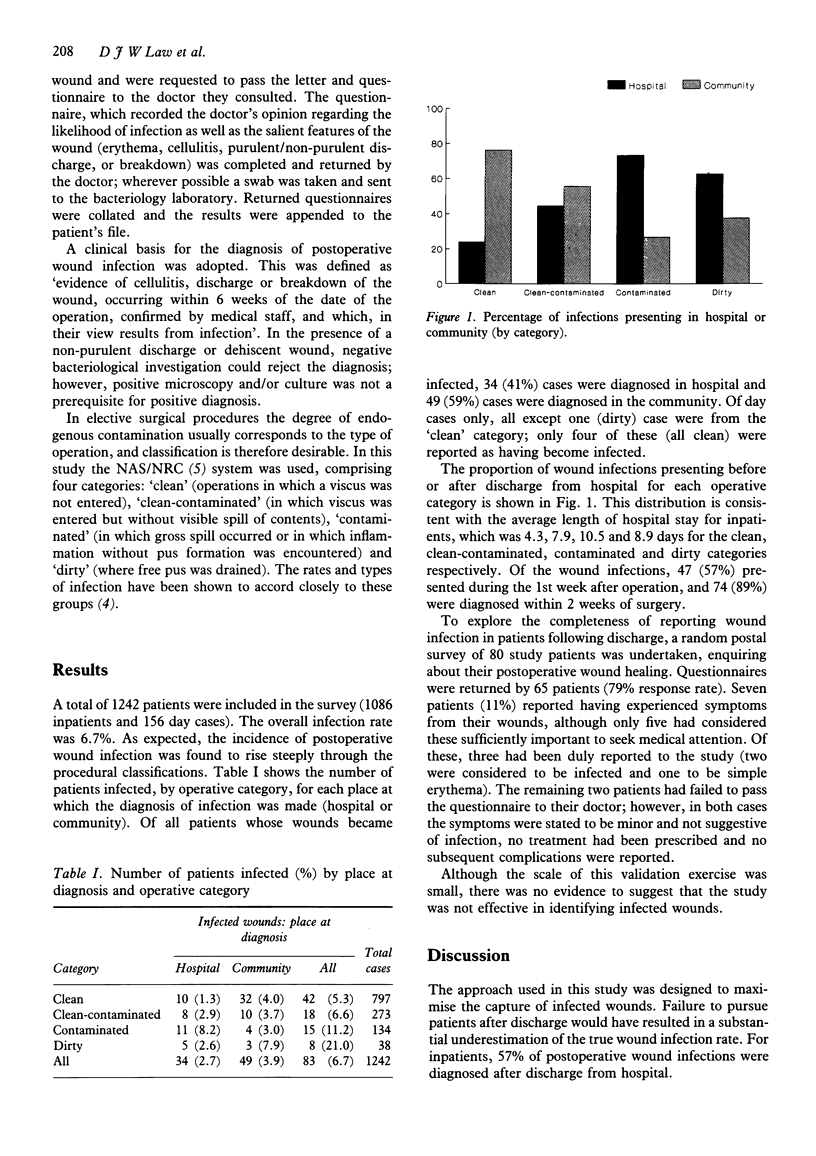Abstract
A prospective survey was carried out in West Dorset to determine the incidence of postoperative wound infection. A total of 1242 patients were included in the survey (1086 inpatients and 156 day cases). The overall infection rate was 6.7%. Although the incidence of infection was consistent with that reported by other studies, the infection rate in the 'clean' surgical category was higher than in most other published reports. Careful surveillance after discharge from hospital may have been responsible for identifying cases of wound infection which otherwise might not have come to the attention of the study. Of patients whose wounds became infected, 34 (41%) cases were diagnosed in hospital and 49 (59%) cases were diagnosed in the community. Failure to pursue patients after discharge would have resulted in a substantial underestimation of the true wound infection rate.
Full text
PDF


Selected References
These references are in PubMed. This may not be the complete list of references from this article.
- Abussaud M. J., Meqdem M. M. A study of some factors associated with wound infection. J Hosp Infect. 1986 Nov;8(3):300–304. doi: 10.1016/0195-6701(86)90127-1. [DOI] [PubMed] [Google Scholar]
- Bates T., Touquet V. L., Tutton M. K., Mahmoud S. E., Reuther J. W. Prophylactic metronidazole in appendicectomy: a controlled trial. Br J Surg. 1980 Aug;67(8):547–550. doi: 10.1002/bjs.1800670805. [DOI] [PubMed] [Google Scholar]
- Bucknall T. E. Factors affecting the development of surgical wound infections: a surgeon's view. J Hosp Infect. 1985 Mar;6(1):1–8. doi: 10.1016/s0195-6701(85)80012-8. [DOI] [PubMed] [Google Scholar]
- Cruse P. J., Foord R. The epidemiology of wound infection. A 10-year prospective study of 62,939 wounds. Surg Clin North Am. 1980 Feb;60(1):27–40. doi: 10.1016/s0039-6109(16)42031-1. [DOI] [PubMed] [Google Scholar]
- Farber B. F., Wenzel R. P. Postoperative wound infection rates: results of prospective statewide surveillance. Am J Surg. 1980 Sep;140(3):343–346. doi: 10.1016/0002-9610(80)90164-6. [DOI] [PubMed] [Google Scholar]
- Hulton N. R., Kiff E. S., Brogan T. D. Surgical sepsis at a district general hospital. J Hosp Infect. 1985 Jun;6(2):140–146. [PubMed] [Google Scholar]
- Leigh D. A. An eight year study of postoperative wound infection in two district general hospitals. J Hosp Infect. 1981 Sep;2(3):207–217. doi: 10.1016/0195-6701(81)90040-2. [DOI] [PubMed] [Google Scholar]
- Polk B. F., Tager I. B., Shapiro M., Goren-White B., Goldstein P., Schoenbaum S. C. Randomised clinical trial of perioperative cefazolin in preventing infection after hysterectomy. Lancet. 1980 Mar 1;1(8166):437–440. doi: 10.1016/s0140-6736(80)90994-0. [DOI] [PubMed] [Google Scholar]
- Rosendorf L. L., Octavio J., Estes J. P. Effect of methods of postdischarge wound infection surveillance on reported infection rates. Am J Infect Control. 1983 Dec;11(6):226–229. doi: 10.1016/0196-6553(83)90005-6. [DOI] [PubMed] [Google Scholar]
- Shapiro M., Muñoz A., Tager I. B., Schoenbaum S. C., Polk B. F. Risk factors for infection at the operative site after abdominal or vaginal hysterectomy. N Engl J Med. 1982 Dec 30;307(27):1661–1666. doi: 10.1056/NEJM198212303072701. [DOI] [PubMed] [Google Scholar]


